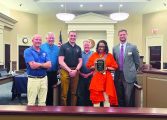Report is unlikely to end debate over Rassawek dig
By Heather Michon
Correspondent
An internal investigation into a whistleblower complaint of unethical practices during a survey of a sensitive archaeological site along the James River has found no credible evidence of management, Fluvanna County announced on Wednesday (Jan 15).
In a 35-page memo to the James River Water Authority (JRWA), attorney Justin Curtis of AquaLaw found that statements made by Eric Mai, former field technician for Circa Cultural Resource Management were “misleading and exaggerated” or simply could not be corroborated.
At the same time, Curtis said “counsel is not qualified to, and does not offer any opinion on the work performed by Circa of [owner and principal Carol] Tyrer” and did not evaluate Circa’s practices for “conformity with accepted standards for professional conduct.”
Point of Fork, at the confluence of the James and Rivanna rivers, is the proposed site of a pumping station designed to carry millions of gallons of water into Louisa County, which would also be used by Fluvanna County. It is also believed to be the site of Rassawek, the chief city of the Monacan Indian Nation at the time of the English arrival in Virginia in 1607.
In October 2019, Mai issued a sworn declaration accusing Tyrer of “illegal, unethical, and unscientific” practices during the archaeological survey of the site conducted between May 2017 and January 2018. This statement came shortly after the Virginia Department of Historic Resources (VDHR) informed the JRWA that Tyrer lacked the professional qualifications required under state and federal law to conduct such surveys.
To evaluate Mai’s claims, Curtis said he interviewed several people involved with the project, including Tyrer; Joe Hines, project manager for Timmons Group, the lead contractor for the pumping station; and Brandon Weaver, a foreman with Faulconer Construction, whose workers performed hundreds of hours of work at the site.
Inadequately prepared and supplied
One of Mai’s claims was that the field staff was inadequately informed about the background and potential sensitivity of the site.
Curtis said that a work plan filed with the VDHR and the Army Corps of Engineers (ACOE) clearly outlined “the significance of the site,” and that Mai and the rest of the crew were provided copies of the work plan.
Mai said in his statement that Tyrer refused to provide them with GPS devices to properly map the site. In her interview with Curtis, Tyrer disputed this claim, “stating that Circa’s staff had and were instructed to use GPS devices in the field to map the transects and positive shovel tests, that all base maps used in the field were generated by Timmons’ GIS staff and land surveyors, and that the project boundaries were well-marked in the field by Timmons’ surveyors prior to the study.”
She also denies Mai’s contention that field staff didn’t have access to Munsell Soil Color Chart books, which archaeologists use to date different layers of soil as they excavate. Curtis said her claims were verified by notations on site maps were Mai and others clearly referenced Munsell layers.
AWOL
Mai said in his statement that Tyrer was often absent from the site. Curtis dismissed the claim by pointing out that the survey had two main stages: from April 2017 to June 2017 and from October 2017 to January 2018. In the early stage, he says, “there was no requirement for Tyrer to be continually present.”
There was no work on the site over the summer of 2017 as the county waited for an anticipatory burial permit in the event the dig uncovered human remains. Mai’s statement, said Curtis, appeared to be “deliberately misleading and intended to convey” that Tyrer had been absent for five months, “when in fact no work took place for four of those months.”
In October 2017, VDHR project review archaeologist Greg LaBudde made an unexpected visit and found Tyrer was not there. Mai said that he had heard from fellow staffers that Tyrer had been upset when she found out about LaBudde’s visit and ordered another employee, Charlie Rutledge, to lie to LaBudde and explain she had just stepped away temporarily if LaBudde reappeared.
Tyrer denied to Curtis that she had asked Rutledge to lie to the VDHR, although she admitted that in a conversation with him in October 2017, he had told her he felt she had implied he should lie.
The attorney said he was “unable to speak” to Rutledge, who has since left Circa.
Curtis said that Tyrer’s apparent absence of the site during LaBudde’s visit was, at worst, a misunderstanding. “After VDHR explained that I was to be onsite every day,” Curtis quoted Tyrer, “I was onsite every day.”
Untrained workers
Workers from Faulconer Construction, another subcontractor working at the site, were used by Tyrer to operate heavy machinery to dig trenches, to dig test pits, and to shake screens to sift soil for artifacts. “It appears likely that the skills of construction workers would be suitable and appropriate to these tasks,” said Curtis.
Mai stated in his declaration that their work was largely unsupervised and “they told me they had no idea what they were looking for.” He also said they sometimes used inappropriate heavy equipment that risked damaging artifacts.
Curtis argued that the construction workers were always supervised, often by Mai himself, and described their participation as “limited.” He dismissed the use of untrained workers by pointing out that “the DHR Guidelines do not mandate that all personnel participating [in] an archaeological field study be qualified archaeologists.”
Not sufficiently reliable
“In summary,” Curtis wrote, “Counsel does not find any of the principal allegations in the Mai Declaration to be credible and/or supported by the available evidence. Thus, Counsel does not believe the Mai Declaration provides information that is sufficiently reliable to base a recommendation for any specific further Board action with respect to Circa and Tyrer.”
The JWRA approved the report at its Jan. i8 meeting, but it is unlikely that this is the final word on the survey.
In late December, lawyers for the Monacan Indian Nation asked the Boards of Supervisors for Fluvanna and Louisa to open an independent investigation into Timmons and Circa to see if they had “defrauded the public during purported archaeological investigations at Rassawek.”
Meanwhile, lawyers for the JRWA have petitioned the Fluvanna County Circuit Court to try to get VDHR to accept Tyrer’s professional qualifications. A hearing date has not yet been set.




